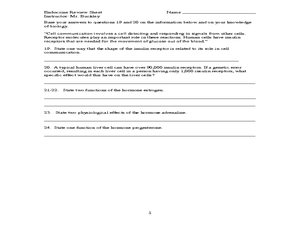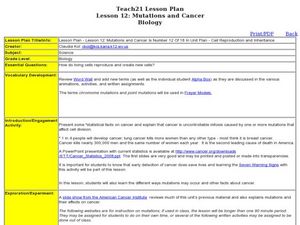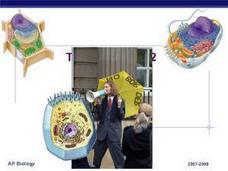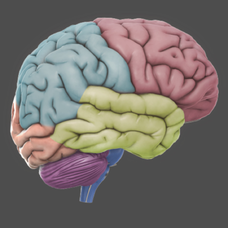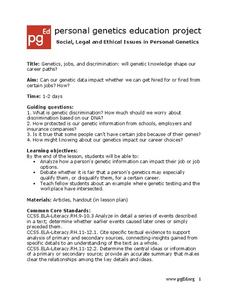Curated OER
Endocrine Review Sheet
Starting with a diagram of the kidneys and urinary tract of the human, this sheet has questions about excretion, blood concentrations of hormones, gland feedback mechanisms and the effects of some hormones.
Curated OER
Cell Respiration Worksheet
Beginning biologists demonstrate their grasp on cellular respiration, photosynthesis, and energy flow though ecosystems when completing this worksheet. Fifteen multiple choice and short answer questions test their knowledge. Because of...
Curated OER
Mutations and Cancer
Students study how cancer cells mutate and affect cell division. In this investigative lesson students view a PowerPoint presentation learn the seven warning signs of cancer.
Curated OER
Fall 2003 Midterm Exam #3
Let there be light! When your physics learners take this midterm exam, light will be their focus. They will show what they know about electromagnetic waves, interference, refraction, reflection, lenses, prisms, and more! The test is...
Curated OER
Bacteria
New species of Bacteria are still being discovered. These Archaebacteria and Eubacteria are described, and examples of the main sub-groups are included along with some diagrams about reproduction, nutrition, and effects.
Curated OER
Proteins
Vocabulary that is essential to this topic is introduced and defined at the start of this slide show. The following slides help students understand proteins and their use and involvement in everyday substances. Great diagrams help your...
Curated OER
Proteins
As long as you have some support information to answer questions that may come up from students, this is an excellent PowerPoint to cover almost all aspects of protein structure and ionization. The sequence of slides has great images and...
Curated OER
Cellular Respiration Oxidation of Pyruvate Krebs Cycle
Diagrams with annotations are shown on each of these eighteen slides, which summarize the processes of respiration. The focus is on the 3-step oxidation process and the Krebs cycle. Students should be able to follow these slides during...
Curated OER
Photosynthesis:The Calvin Cycle
From the light reaction to the Calvin cycle, this presentation contains information about the various stages of photosynthesis. This is a great supplement to some of the biochemistry-heavy presentations about the specific mechanisms....
Curated OER
Evidence of Evolution by Natural Selection
Being able to test a hypothesis is a scientific must. AP Biology pupils can see the process of hypothesis testing through evidence for evolution as seen in natural selection. Slides contain solid information and excerpts from academic...
Curated OER
Tour of the Cell 2
As your class views each slide, they will be introduced to the organelles and structure of the cell. Details about structure and function are given and also some trivia about their frequency and population. There is also some...
Curated OER
Genetically Modified Food (GMF)
Explore genetically modified foods through various experiments. In this biology lesson, students discuss the safety issues related to GMF's. They conduct a PCR analysis to identify the presence of genetic modification.
Science Geek
Intermolecular Forces of Attraction
Chemists love London (dispersion forces)! Presentation begins with an explanation of intermolecular forces including hydrogen bonding, dipole-dipole attraction, and London dispersion forces. It also covers polarity and the relative...
Curated OER
7.012 F’04 Problem Set 1 ~ Biology
Course identification information is included in the upper left corner as well as within the title of this worksheet. If you overlook or remove that information, you are left with a tremendous college biology assignment. There are only...
Curated OER
Human Cloning: Is it Biological Plagiarism?
Is cloning good or harmful? Help your class understand the risks and benefits as they read, research, and discuss human cloning. Individuals form teams, research information, and present to the class before concluding with an in-depth...
Curated OER
Where It Comes From: All About Heredity
Characteristics are not only inherited, but can be acquired through interactions with the environment.
HudsonAlpha Institute for Biotechnology
iCell
View attractive, three-dimensional models of an animal cell, a bacterium, or a plant cell. Suspended in a translucent, undulating cytoplasm, are all of the major organelles for life science learners to examine. They can zoom in, click on...
Cold Spring Harbor Laboratory
3D Brain
Imagine being able to rotate the brain and view interior structures without dissection! This tool allows anatomy masters to do just that. They also learn about the associated functions, disorders, and symptoms of damage to each structure.
Macmillan Education
A Wrinkle in Time Discussion and Activity Guide
As you work through Madeleine L'Engle's A Wrinkle in Time, try out some or all of the 20 questions and activities included here. Useful for discussion questions, group assignments, or individual projects, this resource covers plot as...
Howard Hughes Medical Institute
Winogradsky Columns: Microbial Ecology in the Classroom
Winogradsky columns are ideal for observing the role of bacteria and other microorganisms in an ecosystem. This student activity guide is complete with data tables for observations and analysis questions for processing what was observed....
Personal Genetics Education Project
Genetics, Jobs and Your Rights
Your class will read an overview of the Genetic Information Nondiscrimination Act, passed in 2008 and address the question of whether or not genetic information should be used to influence our career paths. In jigsaw style, they then are...
Cmassengale
Bacteria: Structure and Function
For as small as they are, there sure is a lot of information for young scientists to learn about bacteria. Help simplify the subject with this instructional presentation that explores the structure, nutrition, and reproduction of...
University of California
You Are What You Eat: Testing for Organic Compounds in Foods
We have all heard that we are what you eat, but what are we eating? An informative lesson opens with a discussion of the foods pupils have recently eaten. Then, young scientists perform four experiments on seven different foods to...
University of Colorado
Clay Planets
Why do scientists use models? In the first installment of 22, groups create scale models of our solar system. They then share and discuss their models.
Other popular searches
- Dna Replication
- Dna Structure
- Dna Fingerprinting
- Dna Models
- Dna Replication Worksheet
- Dna Sequencing
- Dna Extraction
- Dna Technology
- Recombinant Dna
- Dna Mutations
- Dna Structure Worksheet
- Mitochondrial Dna


